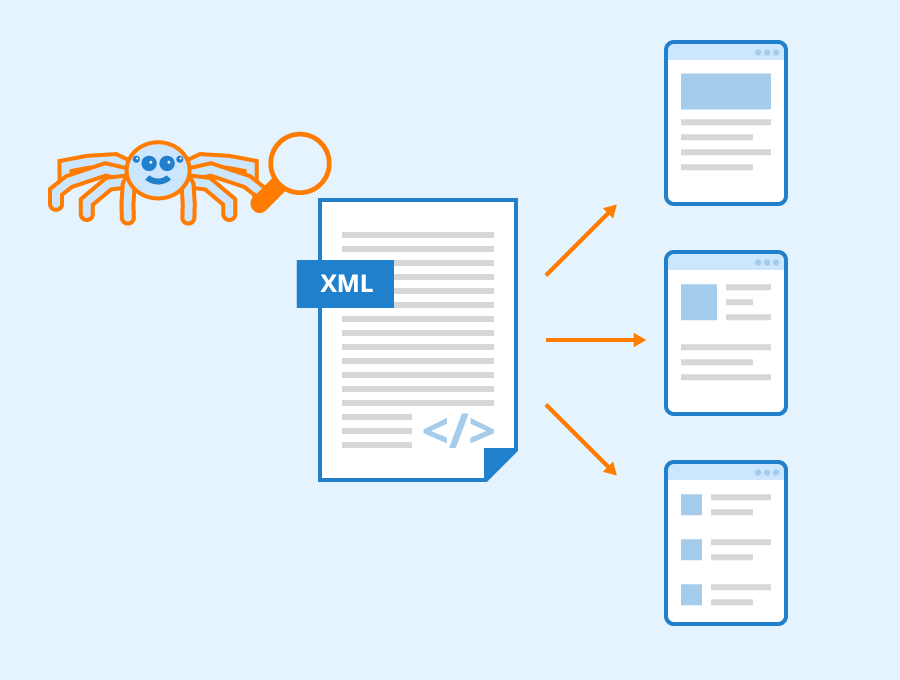Ever wonder why your site’s buried on page 3 of Google? You’re not alone. According to Ahrefs, 90.63% of content gets zero traffic from Google. One major reason? Poor website architecture.
If search engine crawlers can’t easily find and index your site’s pages, you’re basically invisible. But here’s the good news: you can fix this.
In this guide, you’ll learn 7 proven website architecture strategies that make your site easier to navigate, faster to rank, and way less frustrating for both users and bots.
Ready to clean up the mess? Let’s make your site Google’s new favorite.
What Is Website Architecture?

Website architecture is the way your website’s pages are organized and connected. A well-planned website's architecture is essential for both SEO performance and user experience.
A good website structure makes it easy for people to find what they need in just a few clicks. Establishing a clear information hierarchy is a key aspect of website architecture, guiding both users and search engines through your content.
Why it Affects the Google Search Rankings?

Google likes sites that are easy to understand. If your website structure is messy, Google might miss some of your key pages. Effective website architecture should be part of your web development process from the start to avoid costly fixes later.
Here’s how it impacts your rankings:
- Search engine spiders crawl your content better with a flat site architecture
- Well-placed anchor text in contextual links helps Google know what each page is about
- Internal links pointing to relevant pages boost their importance
- A good site architecture helps ensure your new pages are included in google's index quickly
- Most sites struggle with rankings not because of bad content, but because of poor internal structure and unclear navigation paths.
A clear structure helps your pages show up more prominently in google's search results, making it easier for users to find your content.
What Is an Ideal Site Structure?

An ideal site structure means your website is easy for both people and search engines to use. It helps Google find your content and show it in the search results. When your pages are well-organized, users can move around your site without confusion. Structure plays a crucial role.
A smart website architecture also supports a faster crawl by search engine crawlers, especially when you use internal links, a clean url structure, and well-placed pillar pages to enhance your technical seo.
What Does Good Site Architecture Look Like?
You don’t need a fancy layout. You need a smart one. A good site architecture means:
Signs of good architecture:
- Clean url structure like example.com/shoes/men
- No duplicate or broken links
- Easy access to key pages in just a few clicks
- Clear site hierarchy shown in the navigation menu
- Use of existing category pages to organize content and facilitate content management
- Identify the types of content you’ll offer, the key topics you want to cover, and the target keywords you want to rank for in search results.
This isn’t just for big brands. Even a small ecommerce site or blog post can follow these steps. Building an SEO friendly site architecture ensures that both users and search engines can access key pages with minimal friction.
Want to rank better? Structure better.
Top 7 Website Architecture Strategies

1. Build a Flat Website Architecture for Faster Indexing
Flat architecture means all your website’s pages are just a few clicks from the homepage. In a flat website architecture, the home page acts as the central hub, serving as the starting point for navigation and internal linking across your site. It avoids deep layers that are hard to reach.
A flat site architecture helps Google’s index find and crawl your important pages faster. This means your new pages can show up in search results quicker.
How to do it:
- Keep your content within 3 clicks from the homepage
- Use internal links to connect relevant pages
- Make sure pages are linked in your site’s menu and xml sitemaps
Example: Think of an ecommerce site with all product categories visible on the main menu. Easy to explore, right?
2. Use a Clear Hierarchical Structure to Organize Your Site
A hierarchical structure means your content is organized like a tree — with parent pages and child pages. A parent page acts as a central hub that organizes related content, connecting to child pages through internal links and establishing a clear hierarchy within your website architecture.
This makes it easier for search engine spiders and users to follow your website architecture. It also supports good site architecture and shows clear content flow.
How to do it:
- Use categories and subcategories for your pages
- Make sure each category page links to its child pages
- Use breadcrumb navigation to show where the user is
Tip: Add landing pages for key sections to improve site hierarchy and guide users better.
3. Optimize Internal Links to Guide Users and Crawlers

Internal links are links from one page on your website to another. They help people explore and help search engines find and understand your content. A well-placed internal link can guide users to content on the same subject, improving their experience and reinforcing your site's topical authority.
Smart internal linking boosts anchor text usage, spreads link power to key pages, and supports technical SEO. It helps search engines understand what your site’s pages are about.
How to do it:
- Add links from old blog posts to new pages
- Use meaningful anchor text like “view our SEO guide” instead of “click here”
- Place links inside content, not just in menus
Pro Tip: Link from pillar pages to smaller articles or product pages, especially those covering the same subject. This creates a strong, interlinked structure and builds authority within your topic cluster.
4. Structure Category Pages to Support SEO and Navigation
A category page is a page that groups related content or products. It’s a big part of your website architecture, especially for an ecommerce site or a large blog post library.
Well-structured category pages help users find what they’re looking for faster. They also help search engines index pages and rank your content more accurately.
How to do it:
- Group relevant pages under logical categories
- Add short intro content that tells search engines what the page is about
- Link to child pages (like product pages or articles) using internal links
- Include filters or tags carefully to avoid duplicate content
- When adding a new category page, make sure it’s linked from the homepage and included in your XML sitemap for fast indexing
Quick tip: Let’s say you run an online clothing store. Your categories could be Men, Women, Kids. Each category should lead to specific clothing types with easy-to-use filters.
5. Keep URL Structure Simple and Search-Friendly
URL structure refers to the web address of your website's pages. Clean URLs are easier for both users and search engine crawlers to read and remember.
A good url structure supports your overall website structure, helps Google’s index, and improves your rankings in the search results.
How to do it:
- Use short, keyword-rich URLs (like /shoes/mens)
- Avoid random numbers or codes (like /product?id=123)
- Include category pages in the path when needed
- Use hyphens (-) instead of underscores (_)
Quick tip: Google recommends keeping URLs under 75 characters and using real words that help users navigate your site.
6. Support Website Structure with XML Sitemaps and Pillar Pages

An XML sitemap is a file that lists all your website’s pages. A pillar page is a long, detailed page that links to smaller, topically related content.
Search engines use sitemaps to crawl your site faster. Pillar pages help you organize content and create interlinked pages that make sense.
To create topic clusters, group related content around a central pillar page and link each supporting page back to the pillar, forming a structured network within a specific subject area.
How to do it:
- Submit an XML sitemap to Google Search Console
- Create pillar pages around big topics like “Website Architecture Best Practices”
- Link your blog posts and important pages under each pillar
- Keep your internal links pointing back to the pillar to show its value
This approach not only improves organization but also helps build topical authority, signaling to search engines that your site is an expert source on the subject.
Quick tip: If your content is scattered across many other pages, a strong pillar page brings them together. Think of it as your content hub.
7. Design for Both People and Bots—A Well-Structured Site Wins
Your website architecture should work for real people and search engine crawlers. If your site is hard to use or confusing to navigate, visitors will leave. And if search engines can’t understand it, you won’t show up in the search results.
How to make it work:
- Focus on user experience – Make your site’s menu clear. Use headings and short paragraphs.
- Use internal links – Help people and bots jump between relevant pages easily.
- Follow good site architecture rules – Organize your website's pages using a smart site structure.
- Make it crawlable – Submit XML sitemaps and make sure no important pages are hidden.
- Guide both users and bots – Use anchor text that clearly tells what each link is about.
Using consistent navigation across the same site helps maintain user trust and supports easier indexing for search engines.
How Website Architecture Impacts Google Search Results

A solid website architecture isn’t just for looks. It plays a big role in how your site performs in Google search results. Organizing your site's pages with a logical structure and clear internal linking is essential for better crawlability and indexing.
When your pages are organized well, search engine crawlers can do their job faster and smarter. And when that happens, your rankings go up—and so does your traffic, allowing you to create more pages .
- Good Architecture Helps Google Crawl Your Site Faster: Use a flat site architecture (no page should be more than 3 clicks away). Submit XML sitemaps to Google’s index. Avoid dead ends—link your new pages and important pages properly.
- Clear Structure Helps Google Understand Page Relationships: Use a simple hierarchy: homepage > category pages > products or blog posts. Use parent pages and child pages to organize deeper topics. A clear structure ensures both users and search engines can efficiently access all of your website's pages.
- Internal Linking Guides Google’s Ranking Signals: Add anchor text that describes where each link goes. Link related relevant pages using contextual links inside your content. Use internal links pointing to pages you want to rank.
- Website Structure Affects Rich Results and Sitelinks: A well structured site can earn sitelinks and enhanced listings in search results. That means more clicks and better visibility. Make your site’s menu easy to follow. Use consistent page titles and clean url structure.
- Indexing Efficiency Directly Affects Ranking: Fix slow-loading or hidden pages. Use technical SEO tools to find problems. Make sure no pages connect in isolation.
- Architecture Influences Topical Relevance: Create pillar pages that link to interlinked pages. Use internal linking strategically to show topic depth.
SEO Site Architecture Best Practices

A well-organized structure improves the site's user experience by reducing the time it takes for visitors to find the content they need
1. Use internal linking strategically
Think of internal links as helpful signposts. They guide both users and search engine crawlers to the most important pages on your site.
For example, if you write a blog post about product care, link it to your product page. This keeps users on your site longer and tells search engines which pages matter most.
How to do it right:
- Add internal links from blog posts to category pages and landing pages.
- Use clear anchor text like "view all earrings" or "shop men's rings."
- Keep links relevant—don't just add them to meet a quota.
Using internal links pointing to key pages boosts their visibility in Google search results and enhances your overall site structure . It also helps search engine spiders understand your site hierarchy better.
2. Keep a flat site architecture
Flat site architecture means that every page is just a few clicks away from the homepage. It helps users navigate quickly and makes it easier for Google's index to find all your website's pages.
Why it matters:
- Faster indexing of new pages.
- Better user experience.
- More link equity flows to child pages and relevant pages.
Tips:
- Use a simple menu and clear categories.
- Avoid too many levels between parent pages and important pages.
- Include XML sitemaps to support crawling.
Flat website architecture is easier for both users and search engines to understand, especially on an ecommerce site.
3. Optimize category and landing pages

Category pages and landing pages help organize your website structure and match search intent. If optimized well, they often rank high in search results.
How to optimize:
- Add unique, helpful content (not copied from other pages).
- Use contextual links to connect to pillar pages and blog posts.
- Make sure the URL structure is clean and readable.
Category pages should serve as hubs that help search engines and users find topically related content. Landing pages should focus on one product or offer to convert visitors easily.
4. Add contextual and navigational links
Contextual links are links you place inside your content. Navigational links are found in menus and footers. Together, they help search engines and users move around your site easily.
How to do it:
- Use anchor text that tells what the page is about.
- Add contextual links between topically related content—like linking a blog post to a category page.
- Make sure your site's menu includes key landing pages and product categories.
- Update your XML sitemaps so search engine spiders can see your changes.
This practice improves your website architecture by connecting interlinked pages and reducing user drop-off.
5. Avoid orphan pages
Orphan pages are pages on your site that no other page links to. They exist, but search engines may never find them.
How to fix it:
- Regularly audit your site for orphan pages.
- Link them from parent pages or a pillar page.
- Make sure each particular page on your site serves a unique purpose and is linked clearly from relevant categories or hubs.
- Add them to menus or footers.
- Use tools like Screaming Frog or Google Search Console to find these gaps.
Cleaning up orphan pages improves your site structure, makes crawling faster, and boosts your search engine optimization.
6. Consider user-generated content layout
User-generated content (UGC) includes customer reviews, comments, or forums. These appear on different pages and can grow fast.
UGC can help or harm your website architecture. If organized well, it builds trust and brings in more search traffic. If messy, it confuses both users and search engines.
How to manage it:
- Use clear page hierarchy (e.g., product → reviews).
- Place UGC in a separate section with headings.
- Add contextual links back to the main product or service page.
- Don’t forget to monitor for spam.
Organized UGC makes your site easier to read, improves technical SEO, and increases the value of your site’s content.
How to Structure an Ecommerce Site for SEO Success

1. Start with a Flat, Scalable Architecture
A flat site architecture means users and search engines can reach any page in just a few clicks—usually three or fewer.
Flat website architecture makes it easy for search engine crawlers to find and index your website's pages. It helps improve site structure, speeds up crawl time, and gives your most important pages more visibility in search results.
How:
- Keep your ecommerce site no more than three clicks deep.
- Use xml sitemaps and a logical url structure.
- Make sure new pages are easily reachable.
- Keep related child pages connected to their parent pages.
Example: If you run an online clothing store, link category pages like "Men’s Wear" directly from the homepage. Avoid burying them under many layers.
2. Use Clear Category and Subcategory Pages
These are pages that group products into logical buckets like "Shoes" or "Accessories."
Clear category pages tell search engines and shoppers what your site’s content is about. When organized under a hierarchical structure, they improve page hierarchy and illustrate how pages relate while meeting search intent better.
How:
- Create main category pages (e.g., Men's, Women's).
- Add subcategory pages (e.g., Shirts, Pants, Jackets).
- Use anchor text and internal links to connect them.
- Prioritize navigation through the site's menu.
Bonus Tip: Keep your most important pages close to the homepage in your site architecture.
3. Link Strategically Between Products and Categories
This means using internal links to connect related pages like product pages, category pages, and other key sections.
Strong internal linking shows search engine optimization signals about what’s important. It helps users navigate easily and boosts your ranking in google search and google search results.
How:
- Link from product pages back to parent pages.
- Add contextual links like "Similar Products" or "You May Also Like".
- Avoid orphan pages—those with no links pointing to them.
- Use interlinked pages and thoughtful anchor text.
Example: A product page for a black T-shirt should link back to the "Men’s Shirts" category page, and possibly to a blog about styling tips.
4. Optimize URL Structure for Products and Filters

Your URL structure is the web address shown in the browser. For example, /shop/shoes/men is a clear and clean URL.
Simple URLs help search engines like Google understand what each page is about. It also helps users navigate your site better. If your site has messy URLs with lots of numbers or unclear text, people and bots get confused.
How:
- Use short and clear URLs like /product/red-tshirt instead of /product?id=12345.
- Add category pages in the URL path, like /electronics/phones/samsung.
- Don’t create a new page for every filter. Use faceted navigation wisely to avoid duplicate content.
- Keep your website's pages connected through internal linking so no page is left out of Google’s view.
5. Use Unique Content for Each Product and Page
Each product page on your ecommerce site should have its own words, images, and details.
If you copy content from other sites or use the same text across different pages, Google may ignore it. That hurts your search engine optimization.
How:
- Write a short product story. What makes it special?
- Use anchor text to link to related pages like care tips or blog posts.
- Add reviews or user generated content to make pages more helpful.
- Make sure every landing page is unique—even if the products look similar.
6. Build Pillar Pages for SEO Depth
A pillar page is a big page that covers one main topic in detail and links to smaller, topically related content.
Pillar pages give your site depth. They tell search engine crawlers what your site is about. This boosts your google search visibility and helps you rank for harder keywords when following website architecture best practices .
How:
- Choose a main theme like “Running Shoes for Men.”
- Write one big page about it. Include tips, comparisons, and expert info.
- Link to smaller blog posts, product pages, and category pages from the pillar page.
- Keep all internal links clear and use contextual links within the content.
7. Don’t Forget XML Sitemaps and Breadcrumbs
An XML sitemap is a file that lists all your website's pages. Breadcrumbs are small links at the top of a page that show where you are on the site (like Home > Men > Shoes). They both help users and search engines move around your ecommerce site easily.
Search engine crawlers use XML sitemaps to find new pages quickly. If a product page isn’t linked well, the sitemap tells search engines it exists.
Breadcrumbs improve your website structure by showing how pages connect in a clear path. This helps search engines understand your site architecture and also improves the user's experience.
How to Do It:
- Add an XML sitemap to your site. Most ecommerce platforms like Shopify or WooCommerce create it automatically.
- Submit your sitemap to Google’s index using Google Search Console.
- Add breadcrumbs to your category pages and product pages. These act like internal links that guide users and search engine spiders through your site.
- Make sure the breadcrumb trail matches your site’s page hierarchy.
Using XML sitemaps and breadcrumbs is a simple way to boost your website architecture and help your pages show up in search results.
Final Note
Website architecture isn’t just about looks—it’s how search engines and users explore your site. From using a flat site structure to building pillar pages and adding breadcrumbs, every step matters. Want better rankings and more traffic? Start by organizing your site with purpose. A well-structured site helps you win in Google—and with your visitors.

.jpg)
.jpg)
.jpg)
.jpg)
.jpg)
.jpg)
.jpg)
.jpg)
.jpg)
.jpg)
.jpg)
.jpg)
.jpg)
.jpg)
.jpg)
.jpg)
.jpg)
.jpg)
.jpg)
.jpg)
.jpg)
.jpg)
.jpg)
.jpg)
.jpg)

.png)
.png)
.png)
.png)
.png)
.png)
.jpg)
.jpg)
.svg)

